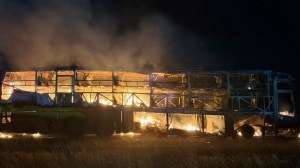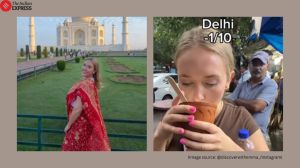“We are natural suspects for both the sides.” Muneeb-ul-Islam talks of two recent incidents to illustrate his point.
In 2016, Islam, a 27-year-old freelance photojournalist from Anantnag in south Kashmir, had reached Sinthan Bijbehara town in the district to cover a stone-pelting protest when he was stopped by personnel of the Central Reserve Police Force (CRPF), allegedly beaten up and “taken as a shield” against the stone-pelters.
This year, he was again at a stonepelting site in Anantnag, when protesters, who were beating up a policeman, allegedly pounced on Islam when they saw him taking photographs, snatched his camera and threw it on the ground, smashing it to pieces.

Conflict makes for gripping visuals, but it also draws a line on the ground. For photojournalists such as Islam, that line can prove dangerous — while security agencies recently accused one of them as inciting protests through his photos, protesters fear that security agencies might use their photographs to identify the stone-pelters.
Story continues below this ad
On September 5, the National Investigation Agency arrested Kamran Yousuf, 23, a freelance photojournalist in south Kashmir, on charges of allegedly instigating people to pelt stones and later shooting photographs of protests and circulating these to news agencies.
“We lead a tough life… That’s how it is. Kamran’s case has only highlighted what we go through everyday,” says Islam.
Today, dressed in an olive-green shirt and baggy cargo pants, Islam and his blue Scooty prepare for another day filled with uncertainty. It is 9 in the morning on a Sunday and Islam has just received a call from a resident in Wanpoh, a village 6 km from his home. “There has been a braid-chopping incident. People have taken to the streets and have blocked the national highway,” he says.
Islam’s usual workday follows no fixed schedule and is often determined by the events that unfold in the four volatile districts of south Kashmir — Pulwama, Anantnag, Shopian and Kulgam. “Some days I set off for work at the break of dawn and sometimes, I am home till noon. And then there are times when I have nothing to do all day,” says Islam, adding that since 2016, such breaks have been few and far between. “We hardly get a day off. There is usually something urgent — encounter, funerals and protests — to shoot,” he says.
Story continues below this ad
Islam spends the next few minutes calling his other photojournalist friends. Around 9.30 am, they meet at Lal Chowk, the town’s main square, and get ready to leave for the village. “We usually move together. We feel safer that way. We are usually the first people to reach the spot, often even before the police,” says Islam.
That was the question that investigators asked of Yousuf, the photojournalist arrested by the NIA: how is it that he was always present at the spot of the protests. “As photojournalists, it is our job to reach the spot,” argues Islam. “Besides, we have made friends everywhere, in every village. They are our source. Whenever something happens there, say, if people are planning a protest or something has happened there, they send us a message or call to inform us”.
For the next 45 minutes, Islam and the other photographers take pictures of the protest at Wanpoh. And when one of them says it is time to move, they ride their scooters back to the town.
“We move together and don’t worry about missing out on the scoops or exclusives. Anyway, in this age of mobile phones, there are no exclusives.”
Story continues below this ad
Back in Anantnag, Islam edits his photographs on his laptop. Half an hour later, he emails them to several news organisations. The Internet is slow and he heaves a sigh of relief when the last batch of photographs is sent.
Islam says he usually drops in at a friend’s place to send his photographs. “We generally send our photographs through mobile hotspot but when the government blocks the Internet during clashes, we rush to the home of an acquaintance or a friend, looking for a broadband connection,” he says. “And then there are days when we can’t send any of our photographs.”
Scanning through the day’s e-papers on his cellphone, looking to see if any of his pictures have been published, has now become a post-breakfast routine for Islam. On days that he has no specific assignment, Islam and other journalist friends meet at the shop of a local newspaper vendor in Anantnag. “We spend an hour at the stall, browsing through all the newspapers and magazines and discussing photography.”
Photography started as a hobby for Islam. But six years ago, after a nudge from his friends, he decided to take it up as a profession. “Like most of the new photographers, I took my first photograph at a stone-pelting protest at Khudwani in Kulgam,” he says.
“My younger brother bought me my first camera because I had no money,” he says, stroking his Canon D700 camera. “I had promised to repay him when I started earning, but it has been six years now….”
Around 12.30 pm, Islam leaves for home for lunch. He lives in the neighbourhood of Sarnal with his mother and three siblings — younger brother Javid and two sisters. His father passed away two years ago, leaving Islam, the eldest of the siblings, in charge of the family.
Story continues below this ad
“But it’s my younger brother’s income that sustains us — he runs a printing and Xerox shop. I only earn around Rs 10,000 a month and even that’s uncertain. After my father died, my family has been telling me to look for another job,” says Islam, who dropped out of his graduation.
After lunch, Islam decides to leave for Achabal, a town of apple orchards some 15 km from Anantnag, to shoot some “off-beat photos”. At Achabal, he takes photographs of people harvesting apples, of men sorting, grading and packing them in wooden and cardboard boxes.
An hour later, he returns to Anantnag, but by then, the Internet has been blocked over rumours of braid-chopping. Back home, he drops his cameras on a pillow on the floor and plonks down. “I can relax now,” he smiles.

 This year, at a stone-pelting site in Anantnag, protesters allegedly pounced on Islam (above) and threw his camera, smashing it to pieces. (Express Photo by Shuaib Masoodi)
This year, at a stone-pelting site in Anantnag, protesters allegedly pounced on Islam (above) and threw his camera, smashing it to pieces. (Express Photo by Shuaib Masoodi)






